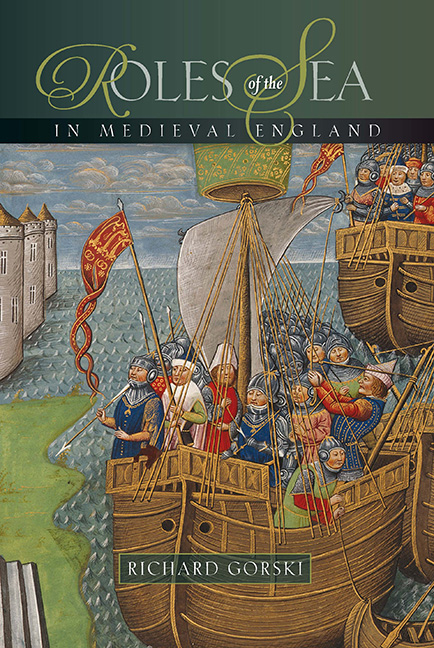Book contents
- Frontmatter
- Contents
- List of Contributors
- Map
- 1 Roles of the Sea: Views from the Shore
- 2 Changes in Ship Design and Construction: England in the European Mould
- 3 The Value of the Cinque Ports to the Crown 1200–1500
- 4 The Contribution of the Cinque Ports to the Wars of Edward II and Edward III: New Methodologies and Estimates
- 5 Keeping the Seas: England's Admirals, 1369–1389
- 6 The Cost-Benefit Analysis of a Fourteenth-Century Naval Campaign: Margate/Cadzand, 1387
- 7 Piracy and Anglo-Hanseatic Relations, 1385–1420
- 8 ‘Herring of Sligo and Salmon of Bann‘: Bristol's Maritime Trade with Ireland in the Fifteenth Century
- 9 How Much did the Sea Matter in Medieval England 167 (c.1200–c.1500)?
- Index
3 - The Value of the Cinque Ports to the Crown 1200–1500
Published online by Cambridge University Press: 05 September 2016
- Frontmatter
- Contents
- List of Contributors
- Map
- 1 Roles of the Sea: Views from the Shore
- 2 Changes in Ship Design and Construction: England in the European Mould
- 3 The Value of the Cinque Ports to the Crown 1200–1500
- 4 The Contribution of the Cinque Ports to the Wars of Edward II and Edward III: New Methodologies and Estimates
- 5 Keeping the Seas: England's Admirals, 1369–1389
- 6 The Cost-Benefit Analysis of a Fourteenth-Century Naval Campaign: Margate/Cadzand, 1387
- 7 Piracy and Anglo-Hanseatic Relations, 1385–1420
- 8 ‘Herring of Sligo and Salmon of Bann‘: Bristol's Maritime Trade with Ireland in the Fifteenth Century
- 9 How Much did the Sea Matter in Medieval England 167 (c.1200–c.1500)?
- Index
Summary
In the Safeguard of the Sea, the first volume of his naval history of Britain, Nicholas Rodger points out that the Cinque Ports are ‘usually given a place of honour in medieval history as the main component of English naval power’, but, he goes on to say, ‘it is not clear that they ever deserved it’. In this he contradicts the belief of many medievalists including, for example, Colin Richmond and Michael Prestwich, that at some undefined period the Ports did indeed provide essential naval service to the crown. Christopher Allmand has been more specific, attributing to the towns ‘virtual control’ of the Straits of Dover in conjunction with the recently captured town of Calais in the later fourteenth century. If Rodger's view is accepted, why did the crown make no attempt to remove the towns’ privileges but indeed confirm them on numerous occasions in the fourteenth century and later – the prestige of belonging to this ancient assembly of ports being, of course, celebrated to this day. Did these privileges continue to be no more than the acknowledgment of past but vague and undefined glories? Or is this a striking example of the supposed medieval dislike of obvious change? Or was there, despite Rodger's views on their naval prowess, some real value for the crown, coming from other aspects of the relationship, in the continued existence of this ancient corporation?
In order to resolve at least some of these questions it is important to distinguish between the service which the Cinque Ports as a chartered confederation owed to the crown and any usefulness they may have had to the realm outside their obligations under their charters. Their charter service, moreover, needs to be put into context along with the similar obligations of other bodies or individuals to contribute to the defence of the realm which formed an intrinsic part of medieval society. Even if the ‘model’ of the feudal system as originally expounded by historians in the sixteenth century has been modified of late, it is clear that the nobility was expected to be actively involved in providing men for royal armies.
- Type
- Chapter
- Information
- Roles of the Sea in Medieval England , pp. 41 - 58Publisher: Boydell & BrewerPrint publication year: 2012



